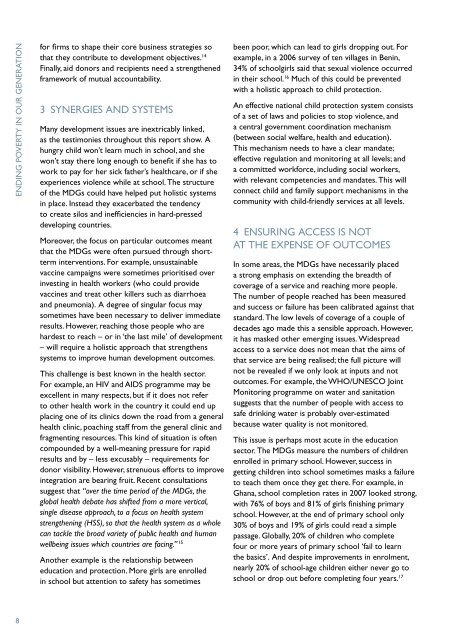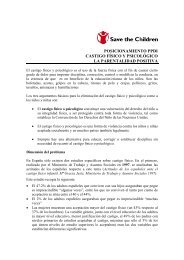ENDING poverty - Save the Children
ENDING poverty - Save the Children
ENDING poverty - Save the Children
You also want an ePaper? Increase the reach of your titles
YUMPU automatically turns print PDFs into web optimized ePapers that Google loves.
<strong>ENDING</strong> POVERTY IN OUR GENERATION<br />
for firms to shape <strong>the</strong>ir core business strategies so<br />
that <strong>the</strong>y contribute to development objectives. 14<br />
Finally, aid donors and recipients need a streng<strong>the</strong>ned<br />
framework of mutual accountability.<br />
3 SYNERGIES AND SYSTEMS<br />
Many development issues are inextricably linked,<br />
as <strong>the</strong> testimonies throughout this report show. A<br />
hungry child won’t learn much in school, and she<br />
won’t stay <strong>the</strong>re long enough to benefit if she has to<br />
work to pay for her sick fa<strong>the</strong>r’s healthcare, or if she<br />
experiences violence while at school. The structure<br />
of <strong>the</strong> MDGs could have helped put holistic systems<br />
in place. Instead <strong>the</strong>y exacerbated <strong>the</strong> tendency<br />
to create silos and inefficiencies in hard-pressed<br />
developing countries.<br />
Moreover, <strong>the</strong> focus on particular outcomes meant<br />
that <strong>the</strong> MDGs were often pursued through shortterm<br />
interventions. For example, unsustainable<br />
vaccine campaigns were sometimes prioritised over<br />
investing in health workers (who could provide<br />
vaccines and treat o<strong>the</strong>r killers such as diarrhoea<br />
and pneumonia). A degree of singular focus may<br />
sometimes have been necessary to deliver immediate<br />
results. However, reaching those people who are<br />
hardest to reach – or in ‘<strong>the</strong> last mile’ of development<br />
– will require a holistic approach that streng<strong>the</strong>ns<br />
systems to improve human development outcomes.<br />
This challenge is best known in <strong>the</strong> health sector.<br />
For example, an HIV and AIDS programme may be<br />
excellent in many respects, but if it does not refer<br />
to o<strong>the</strong>r health work in <strong>the</strong> country it could end up<br />
placing one of its clinics down <strong>the</strong> road from a general<br />
health clinic, poaching staff from <strong>the</strong> general clinic and<br />
fragmenting resources. This kind of situation is often<br />
compounded by a well-meaning pressure for rapid<br />
results and by – less excusably – requirements for<br />
donor visibility. However, strenuous efforts to improve<br />
integration are bearing fruit. Recent consultations<br />
suggest that “over <strong>the</strong> time period of <strong>the</strong> MDGs, <strong>the</strong><br />
global health debate has shifted from a more vertical,<br />
single disease approach, to a focus on health system<br />
streng<strong>the</strong>ning (HSS), so that <strong>the</strong> health system as a whole<br />
can tackle <strong>the</strong> broad variety of public health and human<br />
wellbeing issues which countries are facing.” 15<br />
Ano<strong>the</strong>r example is <strong>the</strong> relationship between<br />
education and protection. More girls are enrolled<br />
in school but attention to safety has sometimes<br />
been poor, which can lead to girls dropping out. For<br />
example, in a 2006 survey of ten villages in Benin,<br />
34% of schoolgirls said that sexual violence occurred<br />
in <strong>the</strong>ir school. 16 Much of this could be prevented<br />
with a holistic approach to child protection.<br />
An effective national child protection system consists<br />
of a set of laws and policies to stop violence, and<br />
a central government coordination mechanism<br />
(between social welfare, health and education).<br />
This mechanism needs to have a clear mandate;<br />
effective regulation and monitoring at all levels; and<br />
a committed workforce, including social workers,<br />
with relevant competencies and mandates. This will<br />
connect child and family support mechanisms in <strong>the</strong><br />
community with child-friendly services at all levels.<br />
4 ENSURING ACCESS IS NOT<br />
AT THE EXPENSE OF OUTCOMES<br />
In some areas, <strong>the</strong> MDGs have necessarily placed<br />
a strong emphasis on extending <strong>the</strong> breadth of<br />
coverage of a service and reaching more people.<br />
The number of people reached has been measured<br />
and success or failure has been calibrated against that<br />
standard. The low levels of coverage of a couple of<br />
decades ago made this a sensible approach. However,<br />
it has masked o<strong>the</strong>r emerging issues. Widespread<br />
access to a service does not mean that <strong>the</strong> aims of<br />
that service are being realised; <strong>the</strong> full picture will<br />
not be revealed if we only look at inputs and not<br />
outcomes. For example, <strong>the</strong> WHO/UNESCO Joint<br />
Monitoring programme on water and sanitation<br />
suggests that <strong>the</strong> number of people with access to<br />
safe drinking water is probably over-estimated<br />
because water quality is not monitored.<br />
This issue is perhaps most acute in <strong>the</strong> education<br />
sector. The MDGs measure <strong>the</strong> numbers of children<br />
enrolled in primary school. However, success in<br />
getting children into school sometimes masks a failure<br />
to teach <strong>the</strong>m once <strong>the</strong>y get <strong>the</strong>re. For example, in<br />
Ghana, school completion rates in 2007 looked strong,<br />
with 76% of boys and 81% of girls finishing primary<br />
school. However, at <strong>the</strong> end of primary school only<br />
30% of boys and 19% of girls could read a simple<br />
passage. Globally, 20% of children who complete<br />
four or more years of primary school ‘fail to learn<br />
<strong>the</strong> basics’. And despite improvements in enrolment,<br />
nearly 20% of school-age children ei<strong>the</strong>r never go to<br />
school or drop out before completing four years. 17<br />
8
















